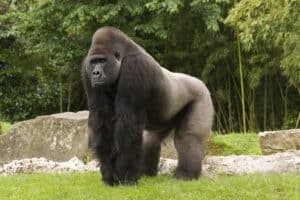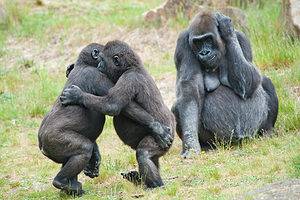Gorillas are the largest of the great apes and one of the most intelligent animals in the world. There exist two extant species of gorilla, both of which are native to Sub-Sahara Africa. The more numerous species, the western gorilla, lives in the tropical forests of Cameroon, the Central African Republic, the Democratic Republic of Congo (DRC), Equatorial Guinea, Gabon, and the Republic of Congo. Meanwhile, the less numerous eastern gorilla lives in the mountains of Rwanda, Uganda, and DRC as well as the lowland forests of DRC. Due to habitat loss and poaching, the IUCN lists both species as Critically Endangered. Currently, conservationists from around the world work tirelessly to protect the remaining gorillas living in the wild and sanctuaries. Gorillas fascinate people with their human-like features and behaviors. That said, can you know the answer to the question “what do gorillas eat?”
If you’re curious to learn more about gorillas’ dietary habits, then you’re in the right place. Today, we’ll conduct a deep study of gorillas’ diets, paying special attention to what foods they eat. We’ll also explore how gorillas forage for food, and how their diet differs in the wild from in captivity. Finally, we’ll examine what baby gorillas eat, and see how their diet differs from an adult gorilla’s. So, come join us as we answer the question “what do gorillas eat.”
What Do Gorillas Like to Eat?
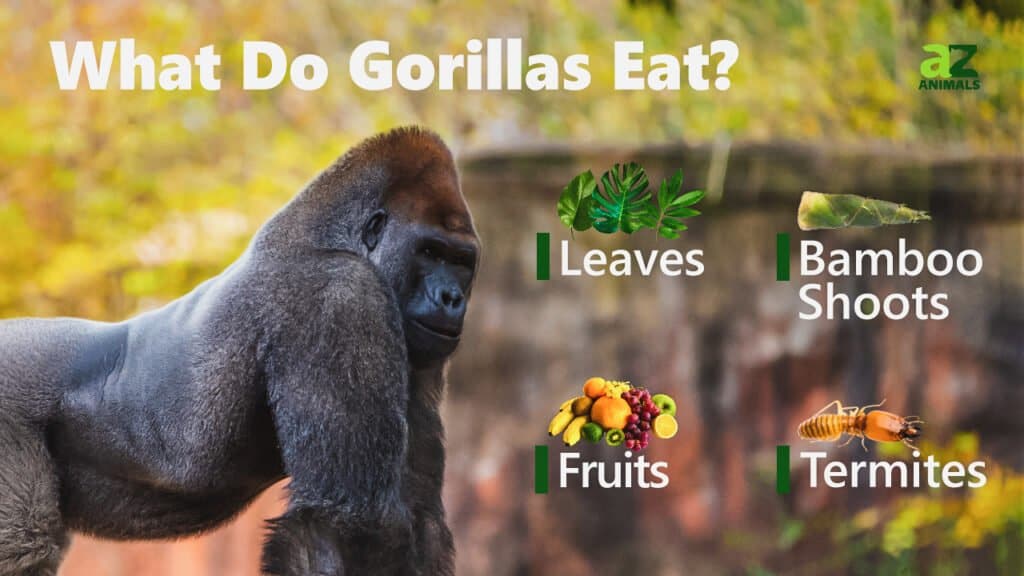
Despite their large, muscled physiques, gorillas are primarily herbivorous and eat mostly plant matter. Gorillas eat a wide variety of fruits and vegetable matter, all of which are locally available in the wild. That said, gorillas will also eat insects, which is where they get the majority of their protein requirement. Although legends exist of man-eating gorillas, these stories are mostly falsifications. Unlike chimpanzees, which will occasionally cannibalize other chimps or eat other animals, gorillas rarely engage in such behavior. While gorilla’s diet can vary depending on its range, there exist similarities in the diet of gorillas regardless of distribution. As such, we’ve identified 10 foods that most gorillas frequently consume. These foods include:
- Leaves
- Stems
- Shoots
- Pith
- Fruit
- Flowers
- Bark
- Herbs
- Ants
- Termites
- Grubs
How Do Gorillas Forage For Food?
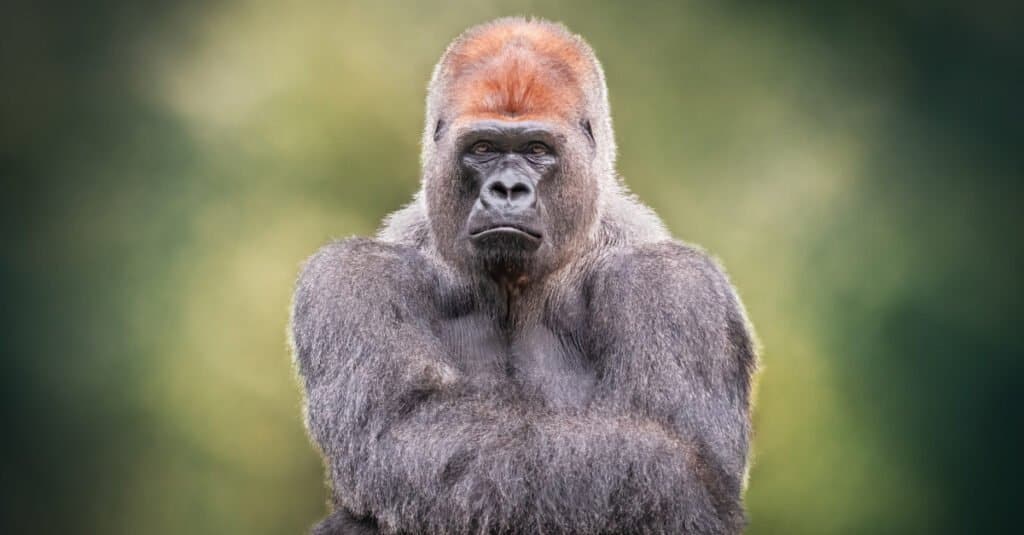
Gorillas rely on their sense of smell and sight to find and identify edible foods.
©iStock.com/SooniosPro
Gorillas have very similar senses to other apes and humans. They rely on sight, smell, taste, touch, and hearing to help them find food and survive in the wild. Sight and smell are arguably a gorilla’s most important senses when it comes to foraging for food. Their eyes enable them to see in color, which allows them to detect which plants are ripe. In addition, gorillas possess binocular vision, which allows them to accurately gauge distances and depth. Gorillas also adapted a finely attuned sense of smell, which they use to identify foreign or strange odors. Since most gorillas live in dense jungles, they often rely on hearing to help them detect threats. Rarely is hearing used to find food, as most of their diet is plant-based. Furthermore, gorillas rely on their deft hands when handling food, such as when tearing apart branches or stems.
The range of the average group of gorillas is between 1 and 6 square miles. That said, during the day, most gorillas travel no more than 1.5 miles in search of food. When not foraging, gorillas will rest before moving on to another area. Due to their smallish ranges, gorillas do not often compete with one another for food. When available, gorillas will also eat aquatic plants as well as terrestrial ones. Upon encountering a termite or ant colony, gorillas may break open the nest to eat the larvae. Gorillas possess strong jaws and teeth adapted for tearing and chewing leaves.
What Do Gorillas Eat in the Wild?
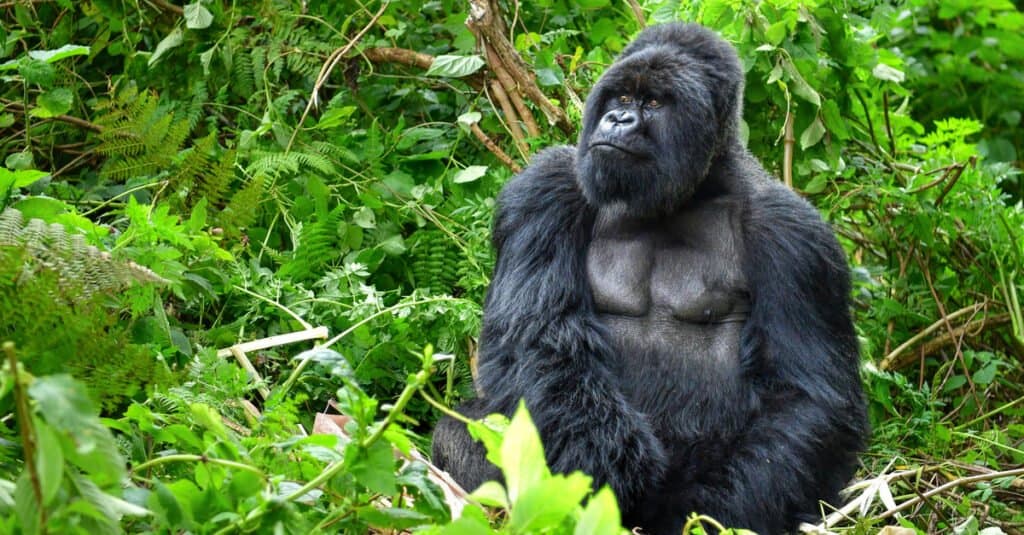
A gorilla relies on its strong jaw muscles to consume food such as nuts and tree bark.
©Onyx9/Shutterstock.com
The diet of a wild gorilla varies depending on the plants available in its home range. In addition, available foods will differ depending on the season, so a gorilla’s diet will change throughout the year. Western gorillas eat a diet that is high in fiber and mostly seasonal foods. Compared to eastern gorillas, fruit makes up a larger portion of a western gorilla’s diet. When fruits are in season, western gorillas will spend more time foraging for fruits. Meanwhile, in the dry season, they will eat more leaves, stems, and other low-quality vegetable matter. On the other hand, eastern gorillas predominantly eat foliage, as fruit is more scarce in their habitats. At most, fruit might make up 25% of an eastern gorilla’s diet.
In total, gorillas eat around 200 different types of plants. Their preferred foods include fruits such as berries, bananas, and guavas. Additionally, gorillas enjoy pith, which is a tissue made from the stems of certain flowering plants. That said, stems and leaves from high-quality plants make up the majority of most gorillas’ diets. Gorillas will often travel long distances to dine on the choicest leaves, shoots, and seeds. During leaner months, they will also eat roots, bark, stems, and other low-quality vegetation. When available, gorillas will also eat termites, ants, or grubs. Over the course of a day, it’s not uncommon for a gorilla to consume 20 to 40 different types of foods.
What Do Captive Gorillas Eat?
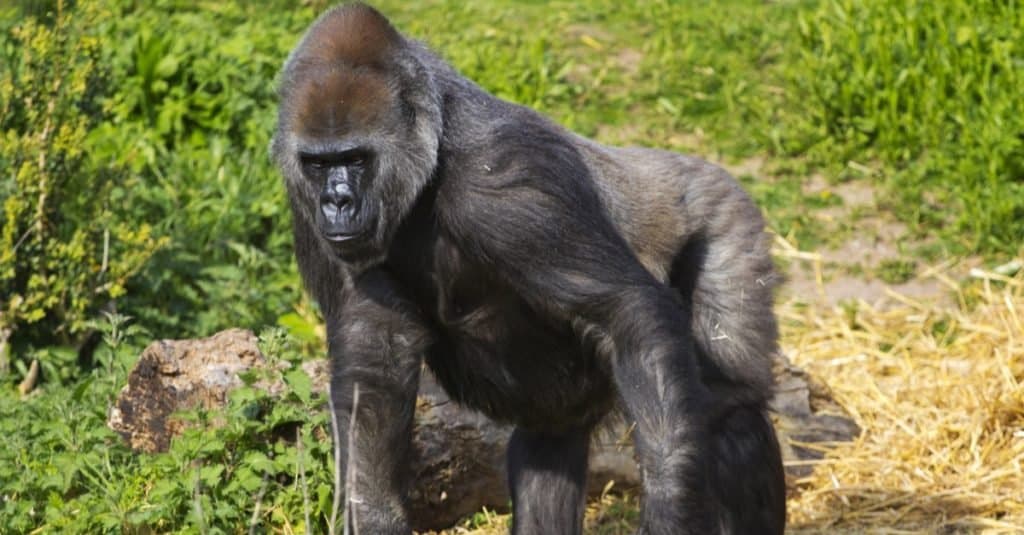
Gorillas eat a wide variety of foliage as well as some fruits.
©Mike Price/Shutterstock.com
Compared to wild gorillas, captive gorillas eat a diet that is more frugivorous than herbivorous. An adult gorilla is capable of eating up to 40 pounds of food in a single day. A captive gorilla may need to be fed up to six times a day. Fruits such as bananas, berries, guavas, and apples rank among the most common foods fed to captive gorillas. In addition, captive gorillas also have access to a wide variety of foliage. Some zoos will also provide gorillas with little treats such as processed cereals. That said, these treats are given only rarely, as they are not part of a gorilla’s natural diet. Due to the difficulty of maintaining ant and termite colonies, captive gorillas rarely have access to insects. However, grubs and larvae may be included as readily available protein sources.
What Do Baby Gorillas Eat?
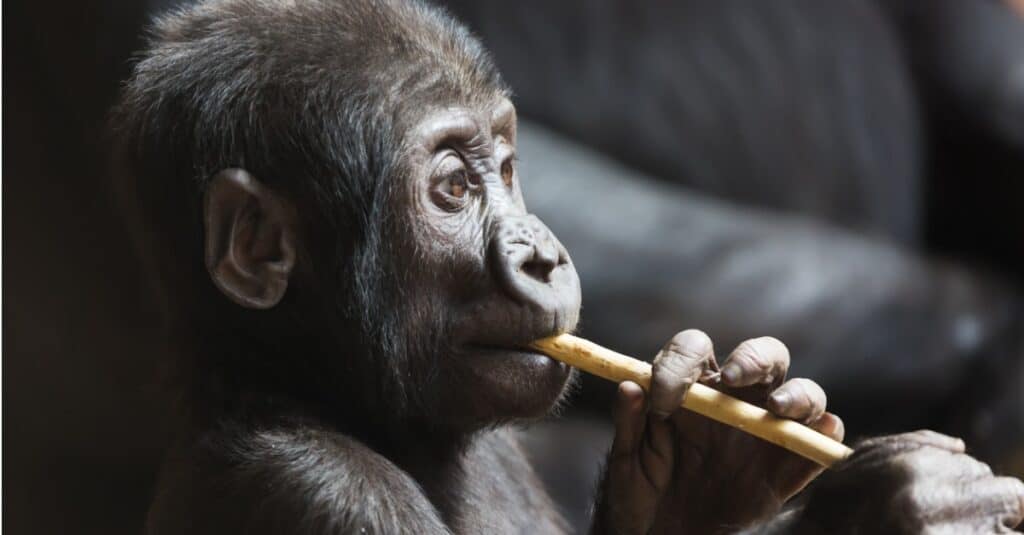
Baby gorillas subsist on their mother’s milk until they are old enough to eat the same diet as an adult gorilla.
©iStock.com/nantonov
At birth, newborn gorillas only weigh around 4.5 pounds but are still very strong. A baby gorilla can grip onto its mother’s body and will remain in close contact for several years. While young, baby gorillas subsist almost entirely on their mothers’ milk. On average, most gorillas will nurse for around 2.5 to 3 years, and which point they will wean off milk. At that point, they can begin to eat the same diet as an adult gorilla. That said, some infant gorillas will also eat some ants or insects, but only in small quantities.
The photo featured at the top of this post is © iStock.com/nantonov
Thank you for reading! Have some feedback for us? Contact the AZ Animals editorial team.



